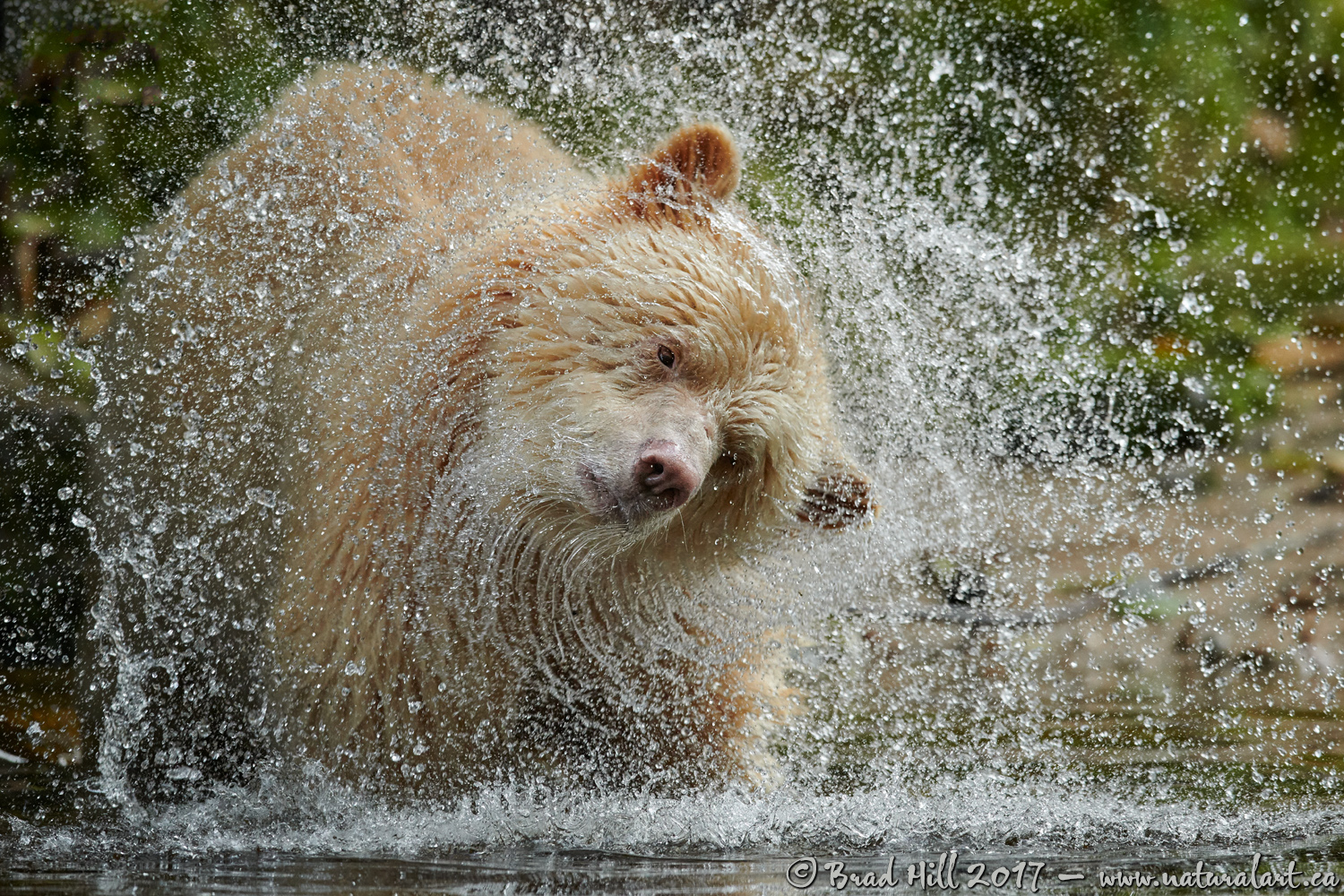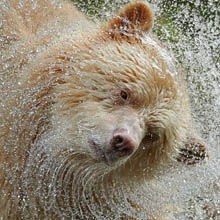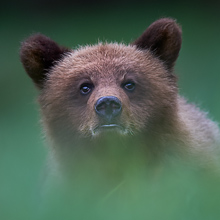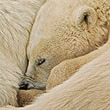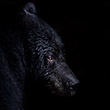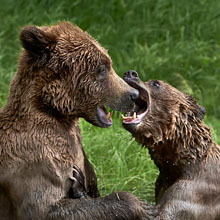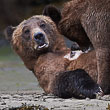Availability: Undetermined - Enquiries?
In the Field
Shaking Up The Status Quo! Gitga'at Traditional Territory, Great Bear Rainforest, BC, Canada. September 27, 2017.
This is a shot I had been hoping to capture for a LONG time! The rare, white Spirit Bear is found primarily in only a few places on BC's central and northern coast in places that are quite tough to access. There are a few locations where, at least in some years, they can be found fairly predictably. But even then you often only get a quick glimpse at them (and commonly only after waiting for many hours!). This means that doing anything "different" - beyond just capturing a shot "of a" Spirit Bear - is normally close to impossible.
But in the autumn of 2017 we had a quite unique experience - we had a Spirit Bear that had fallen in love with ONE spot along a stream (in a shallow eddy) where it spent hours and hours dunking its head in water and feeding on salmon eggs. Presumably the eggs were continuously flowing into the eddy (this unique feeding behavior went on for DAYS, and presumably the bear was staying there for a darned good reason!). Frequently after dunking its head the bear would give a short shake. This gave me (and others) the unique opportunity to work with the bear for an extended period of time and capture a very "different" Spirit Bear shot. I was photographing all aspects of the behavior, but I've always liked "head-shake" shots...so I focused primarily on getting a memorable shake-shot. Of the shots that come out of the session this is my favorite of the bunch...I just love the curving "water beard" that my high shutter speed (1/2000s) froze in time.
I captured this shot shortly after getting my Nikon D850. One of the first things I did with the camera was field test how its ISO performance stacked up against some other high-end Nikon DSLR's (specifically the D800e, D500 and the D5) under controlled conditions. When examining ONLY visible noise onscreen (and paying NO attention to other aspects of how image quality varied with ISO) I found that the D850 showed slightly more visible noise at any given ISO than the D500 and the D800e (and considerably more than the lower-resolution D5).
BUT (and this IS A BIG BUT) what did I find when shooting in the field? Simply put...that even though the D850 images are very slightly noisier than D500 images I still much prefer moderate-to-high ISO images (in the ISO 1600 to about ISO 4000 range) shot by the D850 over those shot by the D500. Why? Well...a moderate amount of image noise is relatively easy to deal with in post-processing. But if a raw image loses colour and tonal range (as is the case in higher ISO images) those are MUCH more difficult to deal with in post. And...I'm am finding that D850 images shot in the ISO 1600 to ISO 4000 (and sometimes higher) range simply LOOK better than those shot with the D500. I THINK this subjective observation is because of better colour and tonality of the D850 (compared to the D500) in that ISO range - and this is probably related to the use of the BSI sensor on the D850 - but I can't say this for certain. Note that this "D850 images look better than D500 images at moderate and high ISO's" observation holds whether I'm looking at full-resolution images onscreen (at 100% magnification) or at resolution-reduced images such as what one uses on websites or, in some cases, when printing.
At this point (after shooting about about 12,000 images with the D850) it is seeming to me that my D850 makes my D500 pretty much completely redundant (at least for my uses). This isn't to say that the D500 isn't an excellent camera - it is. But...with the exception of being able to shoot at 1 more fps (assuming you are using a battery grip on the D850) and for longer bursts than with the D850 (25-40 14-bit lossless compressed raw captures with the D850 vs. 200 with the D500) the D850 does everything the D500 does, but does it with more resolution and, in many cases, better. Whether or not the 60% (or so) higher price of the D850 is justifiable will vary with the user (and uses) of the camera. For me, the D850 is definitely worth the extra bucks.
Here's a larger (2400 pixel) version of this fun shot:
• Shaking Up the Status Quo: Download 2400 pixel image (JPEG: 2.6 MB)
ADDITIONAL NOTES:
1. This image was captured during my autumn"Into the Great Bear Rainforest" Instructional photo tour in the summer of 2017. Each year I offer trips into two different parts of the Great Bear Rainforest as well as one to photograph marine mammals and oceanscapes near the northern tip of Vancouver Island. And, in selected years, I also offer photo tours to locations to capture other highly sought-after subjects, such as Dall Sheep, Bald Eagles, and more. Details about these trips can be found on the Photo Tours page of this website.
2. This image - in all resolutions - is protected by copyright. I'm fine with personal uses of them (including use as desktop backgrounds or screensavers on your own computer), but unauthorized commercial use of the image is prohibited by law. Thanks in advance for respecting my copyright!
3. Like all wildlife photographs on this website, this image was captured following the strict ethical guidelines described in The Wildlife FIRST! Principles of Photographer Conduct. I encourage all wildlife photographers to always put the welfare of their subjects above the value of their photographs.
Behind the Camera
Shaking Up The Status Quo! Gitga'at Traditional Territory, Great Bear Rainforest, BC, Canada. September 27, 2017.
Digital Capture; Compressed RAW (NEF) 14-bit format; ISO 2200.
Nikon D850 paired with Nikkor 400mm f2.8E. Hand-held. VR on and in Sport mode.
1/2000s @ f4; -0.33 stop compensation from "recommended" matrix-metered exposure setting.
At the Computer
Shaking Up The Status Quo! Gitga'at Traditional Territory, Great Bear Rainforest, BC, Canada. September 27, 2017.
RAW Conversion to 16-bit TIFF using Phase One's Capture One Pro 10. Three raw variants (different versions of a single raw capture) processed, with the variants differing only in exposure settings (0.8 stop total difference between the variants).
Further digital corrections on resulting 16-bit TIFF files using Adobe's Photoshop CC 2017 and Light Crafts Lightzone. Photoshop adjustments included compositing (blending) of the three output files from the raw converter and final selective sharpening for web output. Final tone-tweaking performed using LightZone's "tonemapper" tool.
Conservation
Shaking Up The Status Quo! Gitga'at Traditional Territory, Great Bear Rainforest, BC, Canada. September 27, 2017.
Ten percent of the revenue generated by this image will be donated to Raincoast*.
Species Status in Canada**: Not currently listed as Threatened or Endangered.
The "Spirit" Bear is a rare genetically-based colour variant of the common Black Bear (Ursus americana). It has been estimated that less than 300 Spirit Bears exist today. Because the Black Bear is not considered under threat as a species, the Spirit Bear suffers from having the same conservation designation (it should be acknowledged that in British Columbia - the jurisdiction of greatest Spirit Bear abundance - hunting of these white-coated bears is not permitted). For reasons that are not fully understood, the Spirit Bear occurs with greater frequency in a relatively small geographic area within The Great Bear Rainforest of the central and northern coast of British Columbia. In this area 10 to 30% of the bears possess white coats. Many of the black-coloured Black Bears in this region carry the gene for white coats, so allowing hunting of ANY Black Bears in this region can reduce the frequency of the gene for white coats. Thus, to protect the Spirit Bear, it is necessary to prohibit the hunting of ALL Black Bears in this region. And, very unfortunately, the globally unique ecosystem that contains the Spirit Bear is under development pressure, especially from the forestry industry. If this unique environment is altered, we may lose the wonderful genetic anomaly known as the Spirit Bear forever.
*The Raincoast Conservation Society (and Foundation) is an effective and efficient organization that has been fighting for protection of this unique habitat. If you are looking for a meaningful way to contribute to the conservation of this amazing ecosystem, Raincoast will provide maximal "bang" for your conservation dollars.
**as determined by COSEWIC: The Committee on the Status of Endangered Wildlife in Canada












